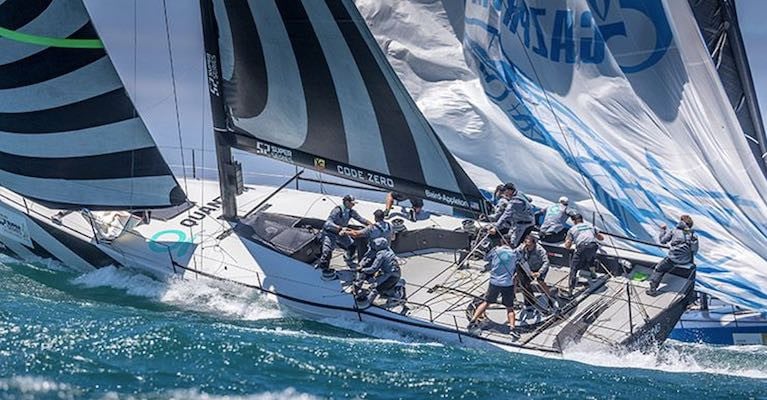Mark Mansfield, Professional sailor and agent for Quantum Sails goes through what options are available on rope and which to use in various circumstances
Rope is one of the most used items on race boats, along with sails.
Rope material has changed a lot in recent years and many owners are confused about what to buy.
Here is a guide to the available options.
There are many suppliers of performance rope worldwide. Some of the Most popular would be Marlow (UK), Liros (Germany), Gottifredi Maffioli (Italy), and Premier Ropes (Holland).
Rope Materials
Polyester
If you go back 30 or 40 years, all ropes were made from Polyester, which would stretch up to 3 or 4 %, so a halyard for a 35-footer, which was approximately 20 metres in length when the sail was hoisted, could stretch 600mm. Much of this stretch was taken out by winding it out with a winch, but still, some stretch/creep came later and as a result wrinkles appeared. It was impossible to set the halyard exactly if you wanted to get optimum sail shape. However the sails also were mainly made of Dacron, so the cloth itself was also moving a lot.
There are still many newer better Polyester ropes in existence which have less stretch than the polyester of previous years which would be suitable for cruising boats that do not mind a little stretch on the luff.
On larger boats, wire was even used on sheets and guys to limit stretch.
Vectran, PBO and Kevlar
- Kevlar has been used in rope in the past but is quite brittle and does not handle UV well. It is difficult to cut so was not generally successful as rope for racing yachts.
- Vectran is still used in some rope making, particularly where high heat resistance is required.
- PBO—used primarily for rigging where flexibility is not required, such as backstays
 Dyneema cascade backstay
Dyneema cascade backstay
Dyneema Rope
Dyneema is the most popular rope used nowadays for yacht racing. Dyneema was a complete breakthrough. It is generally broken down into 3 Dyneema options.
- SK38
- Sk99
- Sk78
SK38
Popular for cruising boats where the stretch of Polyester is not acceptable but where they are not prepared to go with the pricing levels of SK 78 or SK 99.
SK 99
Really top of the line low stretch. This would be the rope of choice for large high-end race boats. It would be approximately. 40% stronger than SK78 and used for a boat's ultra-strength bearing needs such as Code 0 halyards, Tack lines and perhaps even headsail halyards. On average, it would be about 70% more expensive than SK78. Stretch level would be less than 1%
 Alex Thomson's Hugo Boss Open 60 with all rope, mainly SK99, leading back inside the cockpit
Alex Thomson's Hugo Boss Open 60 with all rope, mainly SK99, leading back inside the cockpit
SK 78
The vast majority of Dyneema rope used in yacht racing would be SK78. It would have a stretch level of less than 1.5% and would be used for sheets, halyards, control lines etc... The breaking load is still extremely high and in reality, the rope size needed is often based on the correct size for grip rather than the stretch or breaking loads. For instance, a spinnaker sheet on a 35 footer would normally be 10mm whereas 8mm would be strong enough. 10mm is more popular as it is easier to handle. 10mm would have a breaking strength of about 5000kgs. The breaking load can even be higher if a strong cover such as Technora is used.
Covers, Stripping of Outer cover, splicing, Soft shackles
Covers
Dyneema can have different cover options that can affect the performance and strength of the rope. The majority of Dyneema will have a Polyester cover to help with chafe and assist in winch and clutch holding. However extra strength and chafe resistance can be had by adding covers such as Technora or Vectran. A full Technora cover can add 20% to the breaking load, but will also likely end up about 40% more expensive
Owners purchasing Dyneema rope need to be very aware of the cover they are getting as many may not know the difference. If you are upsizing a rope for grip purposes, it may not be necessary to go for an upgraded cover as the rope upsizing will also bring a higher break load. So, for instance, a Technora covered 10mm rope may have a breaking load of 7000kgs, whereas a Polyester covered 12mm rope may have a similar break load. The negative however is it could be 25% heavier. The cost of each option could be quite similar.
To Strip or not to strip
Halyards and sheets can also have the cover stripped off much of the rope to reduce weight and friction. In particular, you often see halyards half-stripped as weight up the rig is extremely important. The benefit of reduced weight has to be set off against less breaking strength and more chafe. Remember most halyards break where they go around blocks or, in particular, at the jammer. It is important, particularly with halyards, to move the eye splice at the end of the halyard so as to change the point that the rope turns around the blocks or ends up in the jammer. If you decide not to remove the cover, it is often good to splice an eye in both ends so that the halyard can be reversed at the first sign of wear. If a halyard cover breaks at the jammer it normally requires a trip to the chandlery for a new halyard. Also, remember to remove the halyards over the winter as leaving them in place will reduce the performance and life of the rope.
Splicing and soft shackles
 A Dyneema soft shackle
A Dyneema soft shackle
Never knot a Dyneema rope as it can reduce the break load by as much as 50%. They need to be spliced and the norm is an eye splice where a snap shackle is then cow hitched after. Another option to an expensive snap shackle is to use soft shackles. This is a small length of stripped Dyneema with a loop in one end and a knot at the other. The loop is slipped over the knot and that holds it in place. Soft shackles are a lot less expensive. A Tylaska T8 snap shackle can cost €200 whereas a soft shackle may just cost €20. For a spinnaker Halyard or sheet soft shackles may be a bit fiddly, but for headsail halyards, Main halyard, jib sheets they are a great option.
Where to Buy Rope?
Nearly all Chandleries will stock basic levels of Dyneema SK78 with standard Polyester covers, but few will stock the less popular SK99 or Technora covered SK78 due to Stocking cost issues. You likely will need to go to a specialist rigger or rope supplier to get fancier covers or SK99. There are many online suppliers so check around. Make sure it is a rope brand that you know to ensure it is not a knock off spurious product. Markups on rope are high as having 5 or 6 sizes and 5 or 6 colours could mean 30 or 40 reels need to be held in stock. If an owner was looking to change a number of Halyards or sheets, a reasonable discount should be possible.
Nowadays many wire options are now being replaced by Dyneema such as Backstays, Vang adjustments, Outhauls.
For further information or advice on where to purchase, please feel free to contact me.
Mark Mansfield
[email protected] Ph. 087 250 6838



























































